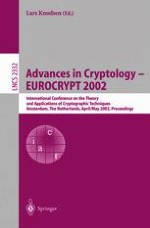2002 | OriginalPaper | Buchkapitel
Key-Insulated Public Key Cryptosystems
verfasst von : Yevgeniy Dodis, Jonathan Katz, Shouhuai Xu, Moti Yung
Erschienen in: Advances in Cryptology — EUROCRYPT 2002
Verlag: Springer Berlin Heidelberg
Enthalten in: Professional Book Archive
Aktivieren Sie unsere intelligente Suche, um passende Fachinhalte oder Patente zu finden.
Wählen Sie Textabschnitte aus um mit Künstlicher Intelligenz passenden Patente zu finden. powered by
Markieren Sie Textabschnitte, um KI-gestützt weitere passende Inhalte zu finden. powered by
Cryptographic computations (decryption, signature generation, etc.) are often performed on a relatively insecure device (e.g., a mobile device or an Internet-connected host) which cannot be trusted to maintain secrecy of the private key. We propose and investigate the notion of key-insulated security whose goal is to minimize the damage caused by secret-key exposures. In our model, the secret key(s) stored on the insecure device are refreshed at discrete time periods via inter-action with a physically-secure - but computationally-limited - device which stores a “master key”. All cryptographic computations are still done on the insecure device, and the public key remains unchanged. In a (t, N)-key-insulated scheme, an adversary who compromises the insecure device and obtains secret keys for up to t periods of his choice is unable to violate the security of the cryptosystem for any of the remaining N - t periods. Furthermore, the scheme remains secure (for all time periods) against an adversary who compromises only the physically-secure device. We focus primarily on key-insulated public-key encryption. We construct a (t, N)-key-insulated encryption scheme based on any (standard) public-key encryption scheme, and give a more efficient construction based on the DDH assumption. The latter construction is then extended to achieve chosen-ciphertext security.
